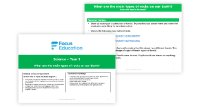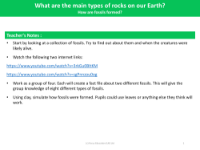How are fossils formed? - Presentation

Science Resource Description
In Year 3 science, pupils are introduced to the fascinating world of rocks and soils, including the process of fossilisation. They learn to categorise different kinds of rocks based on their appearance and simple physical properties, such as sedimentary rocks formed from layers of sand, mud, and pebbles that are compacted over time. The curriculum also covers the formation of fossils, explaining that fossils are the preserved remains or traces of living things that were once trapped within rock. Additionally, students discover that soil is composed of organic matter, including decayed plants and animals, as well as broken bits of rocks and minerals. They are taught to differentiate between the three main rock types: igneous, formed from cooled magma; sedimentary, made from compressed layers; and metamorphic, which are transformed by heat and pressure.
The educational journey includes hands-on activities to cement this knowledge. Pupils are encouraged to research and identify different rocks and understand why some crystals are considered rare and valuable. They work collaboratively to create fact files on various fossils, enhancing their understanding of these ancient remnants. To bring the concept of fossilisation to life, they engage in a practical activity using modelling clay and plaster of Paris to create their own fossil imprints. This tactile experience allows them to simulate the process of fossil formation and appreciate the preservation of history within rocks. The comprehensive approach ensures that by the end of the unit, students have a solid grasp of how rocks and fossils are formed and the significance of these natural phenomena.



